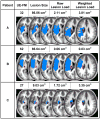Lesion load of the corticospinal tract predicts motor impairment in chronic stroke
- PMID: 20378864
- PMCID: PMC2886713
- DOI: 10.1161/STROKEAHA.109.577023
Lesion load of the corticospinal tract predicts motor impairment in chronic stroke
Abstract
Background and purpose: Previous studies have shown motor impairment after a stroke relates to lesion size and location, but unexplained variability in recovery still exists. In this study, we used lesion-mapping techniques in combination with diffusion tensor imaging to quantitatively test the hypothesis that motor recovery in patients with chronic stroke is inversely related to the proportion of the corticospinal tract (CST) affected by the lesion.
Methods: We studied 50 patients with chronic stroke, all of whom presented with moderate to severe motor impairments in the acute stage, using high-resolution anatomic MRI. We evaluated the degree of motor impairment with the Upper Extremity module of the Fugl-Meyer Assessment. To analyze the relationship between CST damage and impairment scores, we calculated a CST-lesion load for each patient by overlaying the patient's lesion map with a probabilistic tract derived from diffusion tensor images of age-matched healthy subjects.
Results: CST-lesion load was a significant predictor of motor deficit. Infarct size, despite correlating with motor scores, did not significantly predict impairment.
Conclusions: Our results show the degree of functional motor deficit after a stroke is highly dependent on the overlap of the lesion with the CST and not lesion size per se. In the future, automated calculation of CST-lesion load may allow more precise prediction of motor impairment after stroke.
Figures






References
-
- Saver JL, Johnston KC, Homer D, et al. Infarct volumeas a surrogate or auxiliary outcome measure in ischemic stroke clinical trials. The RANTTAS Investigators. Stroke. 1999;30:293–298. - PubMed
-
- Binkofski F, Seitz RJ, Arnold S, et al. Thalamic metbolism and corticospinal tract integrity determine motor recovery in stroke. Ann Neurol. 1996;39:460–470. - PubMed
-
- Crafton KR, Mark AN, Cramer SC. Improved understanding of cortical injury by incorporating measures of functional anatomy. Brain. 2003;126:1650–1659. - PubMed
-
- Schiemanck SK, Kwakkel G, Post MW, et al. Impact of internal capsule lesions on outcome of motor hand function at one year post-stroke. J Rehabil Med. 2008;40:96–101. - PubMed
Publication types
MeSH terms
Grants and funding
LinkOut - more resources
Full Text Sources
Other Literature Sources
Medical

